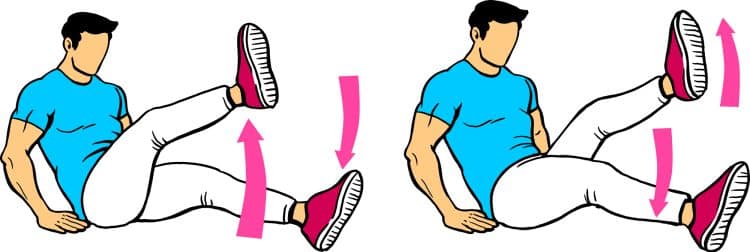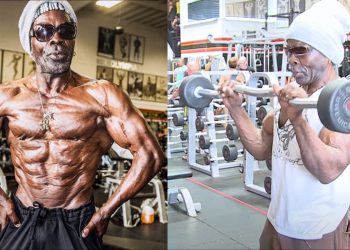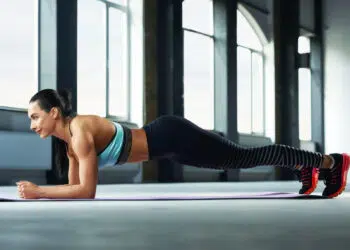Core and abs training are incredibly popular. Almost everyone who works out does at least a few exercises for their midsection, and many exercisers do a lot! Often this is because they want to develop a six-pack, but some people are more interested in improving their core strength and stability.
Regardless of why you train your midsection, it’s reassuring to know that there are dozens, if not hundreds, of different exercises to choose from. Whatever your fitness level, you should have no problem finding at least a few moves to challenge and develop your abs and core strength.
In this article, we reveal why and how to do scissor kicks and also provide you with some great variations and alternatives to this classic exercise.
Scissor Kicks – Muscles Worked
From an exercise science perspective, scissor kicks are an isolation exercise. That’s because only one joint is moving. However, scissor kicks work more than just your abs and actually develop several important muscles.

The main muscles trained during scissor kicks are:
Rectus abdominis
Located at the front of your abdomen, the rectus abdominis is a large flat muscle that runs from your lower ribs and sternum down to the front of your hips and pelvis.
Level Up Your Fitness: Join our 💪 strong community in Fitness Volt Newsletter. Get daily inspiration, expert-backed workouts, nutrition tips, the latest in strength sports, and the support you need to reach your goals. Subscribe for free!
The rectus abdominis is divided into segments by ligamentous lines called the linea alba, which give it a unique six-pack appearance. It is responsible for flexing your spine and also plays a part in lateral flexion and compression of the abdominal contents.
Scissor kicks are an anti-extension exercise, and you’ll be using your abs to hold your spine in a flexed position. As such, this is the muscle you’ll probably feel working most during scissor kicks.
Obliques
Located to the sides of your rectus abdominis, the obliques are basically your waist muscles. They are responsible for lateral flexion and rotation of your spine. There are two sets of oblique muscles – internal and external – and both work together during scissor kicks to stabilize your spine.
Transverse abdominis
Known as the TVA for short, this cylindrical muscle wraps around your midsection like a weightlifting belt. When it contracts, TVA squeezes inward to create intra-abdominal pressure, which supports and stabilizes your lumbar spine. While you might not feel your TVA working, you can be assured it’s very active during scissor kicks.
Iliopsoas
Better known as the hip flexors, the iliopsoas is actually two muscles – the iliacus and the psoas major. They work together to flex your hips, hence their less science-y name. The iliopsoas is very active during scissor kicks, and you’ll feel it working at the front of your hips.
Quadriceps
While scissor kicks are unmistakably an abs exercise, you’ll be using your legs, too. The quadriceps are the muscles on the fronts of your thighs, and you’ll be using them to keep your legs straight. There are four quadriceps muscles – the rectus femoris, vastus lateralis, vastus intermedius, and vastus medialis. Rectus femoris is also involved in hip flexion, working with the iliopsoas.
How to Do Scissor Kicks
Get more from scissor kicks while keeping your risk of injury to a minimum by following these guidelines:
- Lie on your back with your legs straight.
- Place your hands palms down under your lower butt.
- Tilt your pelvis, press your lower back into the floor, and brace your core.
- Lift your legs a few inches off the floor. It’s okay if your knees are slightly bent.
- Raise one leg to roughly a 45-degree angle.
- Lower it back down and simultaneously lift your opposite leg.
- Continue scissoring your legs in this fashion for the prescribed number of reps or designated time.
Pro Tips:
- Do leg crossovers instead of vertical kicks for variation.
- Wear ankle weights to make this exercise more challenging.
- Do not hold your breath. Instead, link your breathing to your leg movements, e.g., in for four kicks and out for four kicks.
- Stop your set if you feel your lower back lifting off the floor or have pain in your lumbar spine.
- Use a slower tempo to make this exercise harder and keep your muscles under tension for longer.
- Try doing scissor kicks without putting your hands under your butt. Instead, rely on your abs to keep your pelvis in the correct position. This makes scissor kicks much more demanding:
Scissor Kick Benefits and Drawbacks
Not sure if scissor kicks are worthy of a place in your workouts? Consider these benefits and then decide!
A functional abs exercise
Scissor kicks work your core as it often has to work with nature – in conjunction with your legs and to prevent unwanted movement of your lumbar spine. As such, this exercise should carry over well to activities outside of the gym.
Better looking abs
While we cannot guarantee that scissor kicks will give you a six-pack, they’ll probably do a good job of toning and firming your midsection.
Scoring a six-pack is all about getting your body fat low enough so that the outline of your abs is visible through your skin. If you watch your diet and train hard, doing scissor kicks will give you better-looking abs.
A challenging exercise
The combination of long levers and kicking means this exercise puts a lot of tension on the target muscles and is quite challenging. If you are an experienced exerciser looking to take your core game to the next level, this could be the exercise you want.
Anywhere, anytime
Scissor kicks require no equipment, so you can do them wherever and whenever you want. You don’t even need a mat to do them because you won’t be rolling up and down your back and putting pressure on your spine. Any flat area will suffice, making this an excuse-free core exercise.
While scissor kicks are a mostly beneficial and safe exercise, there are also a few drawbacks to consider:
Lower back stress
Scissor kicks have the potential to put a lot of stress on your lower back. That’s because the weight of your legs will make you want to arch and even hyperextend your lower back. In addition, the hip flexors attach to your lumbar spine and pull it into extension, putting even more stress on this fragile region.
Your core muscles should prevent this from happening, but as fatigue sets in, you may find your back arching regardless. As such, there is a real risk of lower back injury during scissor kicks, especially for less conditioned exercisers or if you do more reps than you can safely handle.
Not easy to progress or regress
Other than wearing ankle weights, there are no easy ways to make scissor kicks harder. If you want to increase the challenge for your abs, you’ll just have to do more reps. Similarly, there is no real way to make them more manageable. Your legs weigh what they weigh, so you can’t really make this exercise any less demanding.
7 Scissor Kick Variations and Alternatives
Scissor kicks are a challenging and effective core and abdominal exercise, but that doesn’t mean you need to do them all the time. There are several variations and alternatives you can use to keep your workouts productive and interesting:
1. Navy SEAL flutter kicks
Scissor kicks and Navy SEAL flutter kicks look very similar and could even be interchangeable. That said, if you really want to engage your abs to the max, the Navy SEAL variation could be the way to go. Why the name? This exercise is performed by many special forces groups, including the famous SEALs.
Steps:
- Lie on your back with your legs straight. Place your hands lightly on your temples. Press your lower back into the floor and brace your abs. Lift your feet, head, and shoulders a few inches off the floor.
- Without lowering your upper body, kick your legs up and down in an alternating fashion. Four kicks equal one rep.
- Continue for the prescribed duration, number of reps, or until you can no longer keep your lower back pressed into the deck.
Muscles Targeted:
- Primary: Rectus abdominis, transverse abdominis, obliques.
- Secondary: Hip flexors, quadriceps.
Benefits:
- A more intense variation of scissor kicks.
- An awesome core workout for experienced exercisers.
- Do this exercise wherever and whenever you wish, as no equipment is required.
Tips:
- Keep your lower back pressed into the floor at all times.
- Bend your legs slightly to make this exercise easier, or straighten your knees and point your toes to make it harder.
- The bigger your leg kicks, the more challenging this exercise becomes.
2. Reverse crunch
Arguably the most difficult part of scissor kicks is keeping your lower back pressed into the floor. Once your lower back starts to lift, you should stop your set, as continuing could lead to injury. If your lower back lifts during scissor kicks, you should regress your training and work on basic core and abdominal strength with reverse crunches.
Steps:
- Lie on your back with your legs bent and feet flat on the floor. Place your hands under your butt, palms flat. Push your lower back into the floor and engage your abs.
- Lift your legs and curl your knees toward your shoulders, pushing your hips up to the ceiling.
- Lower your feet back to the floor, reset your core, and repeat.
Muscles Targeted:
- Primary: Rectus abdominis, transverse abdominis, obliques.
- Secondary: Hip flexors.
Benefits:
- An excellent exercise for developing basic core strength.
- More accessible than scissor kicks.
- Less lower back strain than with scissor kicks.
Tips:
- Hold the mid-point of each rep for 2-3 seconds to make this exercise more effective.
- Add a twist to increase oblique engagement.
- Progress to doing reverse crunches with your hands next to your hips rather than under them to make this exercise harder.
3. Bicycle crunch
The bicycle crunch combines reverse crunches with scissor kicks. However, because you’re only lifting only leg at a time, some people may find them more manageable. The addition of the twisting action means that bicycle crunches work your obliques a little harder.
Level Up Your Fitness: Join our 💪 strong community in Fitness Volt Newsletter. Get daily inspiration, expert-backed workouts, nutrition tips, the latest in strength sports, and the support you need to reach your goals. Subscribe for free!
Steps:
- Lie on your back with your legs straight and your hands resting on your temples.
- Press your lower back into the floor and brace your core.
- Lift your feet a few inches off the floor.
- Lift your head and shoulders and twist your upper body toward your left side.
- Bend your left leg and pull your knee in toward your opposite elbow.
- Lean back, swap legs, and repeat this movement on the other side.
- Continue cycling your legs and twisting your upper body for the specified number of reps.
Muscles Targeted:
- Primary: Rectus abdominis, transverse abdominis, obliques.
- Secondary: Hip flexors, quadriceps.
Benefits:
- A comprehensive workout for your entire midsection.
- An excellent alternative to scissor kicks.
- Potentially more lower-back friendly than scissor kicks.
Tips:
- Make this exercise easier by resting your straight leg on the floor.
- Terminate your set if you feel your lower back starting to arch.
- Keep your legs bent for a less demanding workout.
4. Alternating leg lowers
Alternating leg lowers are an excellent exercise for building core and hip flexor strength one leg at a time. This exercise also makes keeping your lower back flat on the floor a little easier. Leg lowers could be a more accessible alternative if you struggle with full scissor kicks.
Steps:
- Lie on your back and raise your legs, so they’re vertical. Push your lower back into the floor and brace your core. Place your hands on the floor next to your hips.
- Keeping one leg stationary, lower one leg down until your foot is just a few inches above the floor.
- Return your leg to vertical and then repeat on the other side.
- Alternate legs for the duration of your set.
Muscles Targeted:
- Primary: Rectus abdominis, transverse abdominis, obliques.
- Secondary: Hip flexors, quadriceps.
Benefits:
- A good way to learn how to keep your lower back pressed into the floor.
- A slightly easier exercise than scissor kicks.
- A great exercise for developing lower core and hip flexor strength.
Tips:
- Make sure your lower back is pressed into the floor before you lower either leg.
- Lower your leg slower than you lift it to make the most of your eccentric strength.
- You can also do this exercise with bent knees to make it easier.
5. Lying leg raises
Suppose you have mastered alternating leg lowers and can keep your lower back pressed into the floor. In that case, you are probably ready for lying leg raises. This exercise hits all the same muscles, but you’ll be lifting both legs at the same time, making it far more demanding. While no exercise will give you a six-pack, this exercise will definitely develop stronger, better-toned abs.
Steps:
- Lie on your back with your legs straight and your arms by your sides. Brace your abs and push your lower back into the floor. Raise your feet a few inches off the floor.
- Without bending your knees, lift your legs until they’re vertical.
- Lower your feet to lightly touch the floor, reset your core, and repeat.
Muscles Targeted:
- Primary: Rectus abdominis, transverse abdominis, obliques.
- Secondary: Hip flexors, quadriceps.
Benefits:
- A significant step-up from scissor kicks.
- An excellent exercise for developing lower core strength.
- A challenging move for more advanced exercisers.
Tips:
- Place your hands under your hips if you find it hard to keep your lower back flat on the floor.
- Use ankle weights to make this exercise more challenging.
- Bend your knees as much or as little as you need to make this exercise more manageable.
6. Hanging leg raises
While there is nothing wrong with working your core on the floor, hanging exercises put more load on the target muscles. Even if you are a lying leg raise expert, you will probably find the hanging version much more challenging.
Steps:
- Hang from a pull-up bar using an overhand, shoulder-width grip. Your body and legs should be straight. Brace your core.
- Keeping your knees straight, lift your legs forward and up, so they’re parallel to the ground.
- Lower your legs and repeat.
Muscles Targeted:
- Primary: Rectus abdominis, transverse abdominis, obliques.
- Secondary: Hip flexors, quadriceps, forearms.
Benefits:
- An excellent progression from lying leg raises and scissor kicks.
- A challenging core move for experienced exercisers.
- An effective hip flexor and core strength exercise.
Tips:
- Start each rep from a dead-hang – no swinging your legs up!
- Use gym chalk to stop your hands from slipping during this exercise.
- Make this exercise easier by bending your knees, like this:
7. Hanging scissor kicks
It goes without saying that hanging scissor kicks are much harder than the supine version. That said, if you have mastered hanging leg raises and have good core strength, you’ll probably enjoy the challenge this exercise provides.
Steps:
- Hang from a pull-up bar using an overhand, shoulder-width grip. Your body and legs should be straight. Brace your core.
- Raise your legs to they’re parallel to the floor.
- Kick your feet up and down while keeping your legs raised.
- Continue to the desired number of reps or duration.
Muscles Targeted:
- Primary: Rectus abdominis, transverse abdominis, obliques.
- Secondary: Hip flexors, quadriceps, forearms.
Benefits:
- The most challenging way to do scissor kicks.
- An intense core workout for experienced exercisers.
- An excellent core AND grip exercise.
Tips:
- The higher you raise your legs, the harder this exercise becomes.
- Use a controlled movement – no swinging.
- Use lifting straps to reinforce your grip if necessary.
Scissor Kick Guide FAQs
Do you have a question about scissor kicks or core training in general? Don’t sweat it because we’ve got the answers!
1. How many reps and sets should I use in my core workouts?
Most core exercises use your body weight for resistance, which is an unmodifiable load. As such, you cannot change the weight to make your chosen exercise easier or harder, which makes it hard to prescribe a specific number of reps.
So, rather than suggesting 10, 15, or 20 reps per set, just rep-out to within a couple of reps of failure. With scissor kicks, this would be just before your lower back starts to lift off the floor.
Reaching this level of fatigue will trigger increases in core strength and stability.
In terms of sets, you should be able to fully fatigue your muscles in 3-4 sets. If you feel like you need more, you are probably resting too long between sets or not pushing your muscles close enough to failure.
2. Scissor kicks hurt my lower back – what gives?
The most likely cause of back pain during scissor kicks (and most other core exercises) is hyperextension of your lumbar spine or lower back. Once your abs begin to fatigue, you will start to lose control of your lumber spine, and it will arch.
For that reason, you should a) make sure you start your set with your lower back pressed into the floor and b) terminate your set when you cannot keep your back flat.
If your lower back lifts during scissor kicks, you should do fewer reps or select a less challenging exercise, such as reverse crunches.
These steps should help eliminate lower back pain. But, if it persists, you may benefit from some medical advice, as there could be a problem that needs further investigation.
3. Will scissor kicks give me a six-pack?
Six-pack abs are a common exercise goal, and many people do abs training specifically because they want a sculpted, ripped abdomen. However, getting a six-pack is more about your diet than your workouts. For your abs to be visible, you need to get your body fat down to around 10% or less for men and 15% or less for women.
Direct abs exercises may help thicken your abdominal wall, so it shows through at a slightly higher body fat percentage. Still, they won’t magically melt fat from your stomach. Sadly, there is no such thing as spot reduction.
So, train your abs hard to make them stronger and more prominent, but if you want a six-pack, you need to shed the fat that’s covering them, and that means calorie restriction and a weight-loss diet.
4. Are scissor kicks safe?
No exercise is 100% safe as, even with a thorough warm-up and good technique, injuries can happen anyway. That said, scissor kicks are one of the risker core exercises you can do.
The problem with scissor kicks is the hip flexors pulling your lumbar spine into extension while you use your core to keep your lower back flat on the floor. This creates a lot of shearing force, which could hurt your lower back.
Because of this, you should avoid scissor kicks if you have a history of lower back problems, you cannot maintain a neutral spine while doing them, or feel them more in your back than your abs.
Don’t let FOMO get you down, though; there are plenty of equally effective exercises you can do, several of which are listed in this article.
5. Are scissor kicks and upper or lower abs exercise?
Your rectus abdominis is one long, flat muscle, and there is no upper or lower abs. You either contract your abs, or you don’t. That said, you can use your abs to lift your shoulders or hips, giving the impression of upper and lower abs.
So, because scissor kicks involve lifting your hips, you may feel them a little more in the lower part of your abdomen. However, to do scissor kicks properly, you must engage the entire rectus abdominis muscle. Focusing only on the bottom part will make scissor kicks much harder than they already are.
To answer the question, scissor kicks are a total abs exercise, which is what makes them such an effective workout.
Scissor Kicks Guide – Wrapping Up
Scissor kicks are an old-school core exercise that used to be very popular. However, because of the risk of lower back strain, it’s fallen out of favor, and many exercisers and fitness experts have stopped doing it.
While the risk is undeniable, scissor kicks are not inherently dangerous. Providing you are strong enough to maintain core stability and keep your lower back pressed into the floor, they should be safe for experienced exercisers.
So, add scissor kicks to your core workouts to challenge and develop your core. But, if you feel them in your lower back, fix your form or select a less demanding exercise. Do not persist if they cause you pain.
Interested in measuring your progress? Check out our strength standards for Scissor Kicks, Flutter Kicks, Reverse Crunches, and more.








